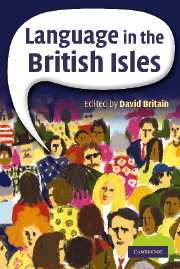Book contents
- Frontmatter
- Contents
- List of figures
- List of tables
- List of contributors
- Acknowledgements
- Map of the British Isles
- Introduction
- Part I English
- Part II The Celtic Languages
- 11 The history of the Celtic languages in the British Isles
- 12 Gaelic
- 13 Irish
- 14 Welsh
- Part III The Other Languages of the British Isles
- Part IV Applied Sociolinguistic Issues
- References
- Index
13 - Irish
Published online by Cambridge University Press: 16 January 2010
- Frontmatter
- Contents
- List of figures
- List of tables
- List of contributors
- Acknowledgements
- Map of the British Isles
- Introduction
- Part I English
- Part II The Celtic Languages
- 11 The history of the Celtic languages in the British Isles
- 12 Gaelic
- 13 Irish
- 14 Welsh
- Part III The Other Languages of the British Isles
- Part IV Applied Sociolinguistic Issues
- References
- Index
Summary
Introduction
Until the thirteenth century speakers of Irish, together with the related languages Scottish Gaelic and Manx, formed a single speech community. Thereafter, socio-political developments fragmented the larger community and substantial morphological and phonological differences developed. These historical connections notwithstanding, in this chapter the primary focus concerns the Irish language, its history and current situation on the island of Ireland.
Linguistic history
Most scholars divide the historical development of Irish into four periods on the basis of socio-historical and/or linguistic evidence. These periods are, by convention, referred to as Old Irish, Middle Irish, Early Modern and Modern Irish.
Old Irish (500–900)
Irish appears to have been spoken in Ireland from at least the early centuries of the Christian era. While it is clear that the language was first brought to Ireland by Celtic groups migrating from continental Europe, a precise date for its introduction into the island has not been established.
The earliest written evidence of the language spoken in Ireland dates from the fifth and sixth centuries, when a form of writing known as Ogham was developed. This was based on the Latin alphabet and was written along the edges of stone monuments as a series of coded notches cut into the stone. The earliest written sources with continuous texts in Irish – glosses and commentaries on biblical texts – date from the seventh century. Later sources include a large number of lyric poems and epic tales.
- Type
- Chapter
- Information
- Language in the British Isles , pp. 218 - 236Publisher: Cambridge University PressPrint publication year: 2007

